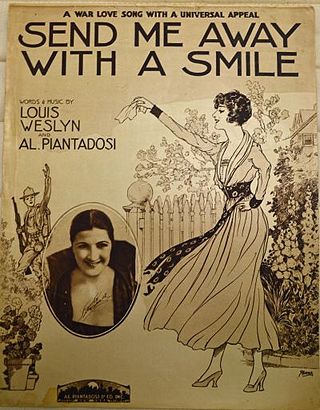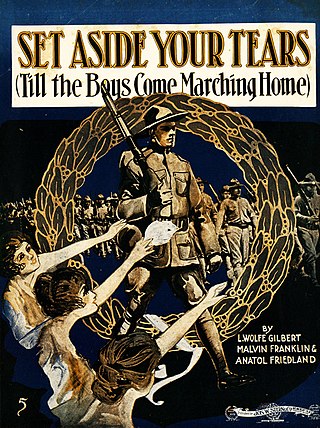Related Research Articles

Dear Old Pal of Mine is a World War I song written by Harold Robe and Gitz Rice. The song was first published in 1916 by G. Ricordi & Co. in New York, NY.

When the Clouds of War Roll By is a World War I song composed by Earl Haubrich with lyrics by Nat Binns. It was published in 1917 by Ted Browne Music Co. in Chicago, Illinois.
There's a Garden of Crosses in No Man's Land is a World War I song written by William Robinson and composed by Gus Wackrow. The song was published in 1918 by the Elite Publishing Company in Boston, MA.
"Lafayette " is a World War I song written and composed by Mary Earl, which was a pseudonym of Robert A. King. It was published in New York, New York by Shapiro, Bernstein, & Co. in 1918. The sheet music cover, illustrated by Albert Barbelle, depicts soldiers marching with fixed bayonets below a statue of Lafayette in silhouette.

"I'm Giving You To Uncle Sam" is a World War I song written by Thomas H. Ince and composed by Victor Schertzinger. The song was published in 1918 by Southern California Music in Los Angeles, CA. The sheet music cover depicts soldiers charging out of a trench with the US Capitol and a flag in the background.

"America's the Word for You and Me" is a World War I song written composed by Jacob J. Tanner Jr. The song was published in 1918 by Jacob J. Tanner Jr., in Pittsburgh, Pennsylvania. The sheet music cover depicts a photo of President Wilson and the head of Uncle Sam with an inset of George Washington.

Johnny's in Town is a World War I song written by Jack Yellen and composed by George W. Meyer & Abe Olman. This song was published in 1919 by Leo. Feist, Inc., in New York, NY. The sheet music cover, illustrated by Rosenbaum Studios, depicts a cartoon soldier winking with women in the background.
"Give a Little Credit to the Navy" is a World War I song written by Buddy DeSylva & Gus Kahn and composed by Albert Gumble. This song was published in 1918 by Jerome H. Remick & Co., in Detroit, MI.

"Military Waltz" is a World War I song composed by Frederic Knight Logan. This song was published in 1917 by F.J.A. Forster, in Chicago, Illinois. The sheet music cover features three soldiers dancing with women in a ballroom.
While You're Over There in No Man's Land, I'm Over Here in Lonesome Land is a World War I song written by Jessie Spiess and composed by Jack Stanley. The song was first published in 1918 by Will Rossiter in Chicago, Il. The sheet music cover, illustrated by Starmer, features a woman knitting with a battle scene above.
Lou Davis was an American songwriter, and author associated with Tin Pan Alley. He was also a businessman in the wholesale meat business. His primary musical collaborators were Abel Baer, Henry Busse, Harold Arlen, Henry Lange, and J. Fred Coots. Several of his most notable songs include "Hot Lips", "A Precious Little Thing Called Love", "Deep in the Arms of Love", "Here Comes My Ball and Chain", and "I'm Croonin' a Tune About June".

Send Me Away With A Smile is a World War I song written by Louis Weslyn and composed by Al Piantadosi. The song was first published in 1917 by Al. Piantadosi & Co., Inc. in New York, NY. The sheet music cover depicts a woman waving to a soldier from a fenced yard with an inset photo of Rita Gould.

Set Aside Your Tears (Till the Boys Come Marching Home) is a World War I song written and composed by Wolfe Gilbert, Malvin Franklin, and Anatole Friedland. The song was first published in 1917 by Jos. W. Stern & Co. in New York, NY. The sheet music cover depicts a woman waving to marching troops.
We'll Carry The Star Spangled Banner Thru The Trenches is a World War I song written by Daisy May Pratt Erd. The song was first published in 1917 by Lang & Mendelsohn in Boston MA. The sheet music cover depicts soldiers advancing over barbed wire with a flag waving.
When I Come Back To You is a World War I song written and composed by William Tracey and Jack Stern. The song was first published in 1918 by Douglas & Newman Music in New York, NY.The sheet music cover depicts a soldier hugging a woman with the Liberty Bell in the background.

Let's All Be Americans Now is a World War I song written and composed by Irving Berlin, Edgar Leslie, and George W. Meyer. The song was first published in 1917 by Waterson, Berlin & Snyder Co., in New York, NY, appearing in the Broadway musical, 'Dance and Grow Thin'. The sheet music cover depicts a soldier with his rifle and silhouetted marching soldiers in the background. A popular recording in 1917 was made by the American Quartet.
Uncle Sam and His Battering Ram is a World War I song written by Robert P. Hall and composed by Ida K. Mervine. The song was first published in 1918 by Mervine & Hall Music in Phoenix, AZ. The sheet music cover features Uncle Sam pointing to the Kaiser as a ram butts him in the stomach.
Under the American Flag is a World War I song with words by Andrew B. Sterling to music by Harry Von Tilzer. The song was first published in 1915 by Harry Von Tilzer Publishing Co. in New York, NY. The sheet music cover depicts a man hugging a woman, with an inset photograph of the composer.
"Welcome Home" is a World War I song written by Bud Green and composed by Edward G. Nelson. The song was first published in 1918 by A.J. Stasny Music Co., in New York, NY. The sheet music cover depicts soldiers being welcomed home by men and women.
Where Do We Go From Here? is a World War I song written by Howard Johnson and composed by Percy Wenrich. The song was first published in 1917 by Leo Feist, Inc., in New York, NY. The sheet music cover features a photo of Collins and Harlin.
References
- ↑ Tyler, Don. Hit songs, 1900-1955: American popular music of the pre-rock era. Jefferson, N.C.: McFarland, 2007. P. 1462-463 ISBN 978-0-7864-2946-2. OCLC 76961274
- ↑ Vogel, Frederick G. (1995). World War I Songs: A History and Dictionary of Popular American Patriotic Tunes, with Over 300 Complete Lyrics. Jefferson: McFarland & Company, Inc. p. 82,157, 165, 208, 214, 296. ISBN 0-89950-952-5. OCLC 32241433.
Bibliography
- Tyler, Don. Hit songs, 1900-1955: American popular music of the pre-rock era. Jefferson, N.C.: McFarland, 2007. ISBN 978-0-7864-2946-2. OCLC 76961274
- Vogel, Frederick G. World War I Songs: A History and Dictionary of Popular American Patriotic Tunes, with Over 300 Complete Lyrics. Jefferson: McFarland & Company, Inc., 1995. ISBN 0-89950-952-5. OCLC 32241433